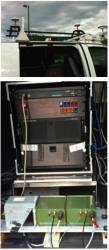Brit Military Visit May Hasten Resolution of GPS Signal Patent Dispute
 Peter Luff, UK Minister for Defence Equipment, Support and Technology (Image from Peter Luff’s MP website)
Peter Luff, UK Minister for Defence Equipment, Support and Technology (Image from Peter Luff’s MP website)The U.S. visit of a high-level official from the British Ministry of Defense (MoD) is spurring efforts to settle a dispute over a patent that could drive up prices on satellite navigation receivers for users around the world.
By Dee Ann Divis





